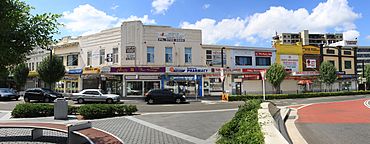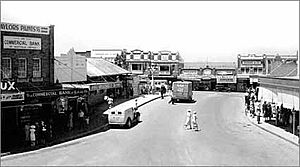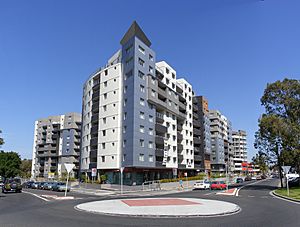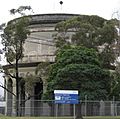Bankstown facts for kids
Quick facts for kids BankstownSydney, New South Wales |
|||||||||||||||
|---|---|---|---|---|---|---|---|---|---|---|---|---|---|---|---|

Bankstown CBD
|
|||||||||||||||
| Population | 32,113 (2016 census) | ||||||||||||||
| Established | 1795 | ||||||||||||||
| Postcode(s) | 2200 | ||||||||||||||
| Elevation | 29 m (95 ft) | ||||||||||||||
| Location | 16 km (10 mi) south-west of Sydney CBD | ||||||||||||||
| LGA(s) | City of Canterbury-Bankstown | ||||||||||||||
| State electorate(s) |
|
||||||||||||||
| Federal Division(s) | |||||||||||||||
|
|||||||||||||||
Bankstown is a busy suburb located in the south-west of Sydney, in New South Wales, Australia. It is about 16 kilometres south-west of the main city centre of Sydney. Bankstown is part of the City of Canterbury-Bankstown local government area. It used to be the main centre for the City of Bankstown before 2016. It is the most populated suburb in the Canterbury-Bankstown area.
Contents
History of Bankstown
Before European settlers arrived, the area of Bankstown was covered by thick forests. The land belonged to the Bidjigal people, an Aboriginal group. They strongly resisted the new European settlers. This resistance ended around 1816 after many of their leaders were captured or killed. A disease also spread among the Aboriginal people, which further reduced their numbers.
In 1795, explorers Matthew Flinders and George Bass explored the Georges River. They told Governor Hunter that the land along the river was very good. Governor Hunter then visited the area himself. He decided to start a new settlement there, which he named Bank's Town. Today, we write it as one word: Bankstown.
Hunter named the area after Sir Joseph Banks. Sir Joseph Banks was a famous botanist who sailed to Australia with Captain James Cook in 1770. Part of the first European settlement area along the river is now protected as Mirambeena Regional Park.
The first town hall and council offices were built in 1898. They were located on the northern side of the Hume Highway. In 1918, the council offices moved to a new building in South Terrace. This building is still there today and has shops inside it.
Bankstown in World War II
During World War II, Bankstown became a very important place. Bankstown Airport was set up as a key air base for the war effort. When General Douglas MacArthur came to Australia, the airport was given to US Forces. It became home to US fighter squadrons from 1942 to 1944. Later, in 1945, the British Fleet Air Arm took control until 1946. Then, it was given back to the RAAF.
An RAAF unit, called No. 1 Fighter Sector RAAF, used the Capital Hall in Bankstown. This unit was created in Bankstown in February 1942. Their living quarters were nearby. In 1945, this unit moved into a special underground building in Bankstown. This building is known as the Bankstown Bunker.
World War II also started Bankstown's industrial growth. Before 1945, there were not many factories here. But between 1942 and 1954, things changed a lot. A company called Hawker De Havilland built a factory at the airport. They made Mosquito bombers there. Today, Bankstown has over seven thousand businesses.
After World War II
After World War II, Bankstown's population grew very quickly. Many people moved here from inner-city areas. Also, many migrants came from Europe. Later, people came from Asia, the Middle East (especially Vietnam and Lebanon), and other parts of the world.
The Bankstown Council moved to its third building in 1963. This was the Civic Centre, which included the 'Roundhouse' council chambers. This building is still used today. The current town hall was built in 1973. The old administration building was destroyed by fire in 1997. The council offices then moved to Bankstown Civic Tower in 1999. On 13 June 2000, the park where the old building stood was named Paul Keating Park.
On 27 May 1980, Queen Elizabeth II visited Bankstown. During her visit, Bankstown was officially given the status of a city.
Bankstown Bunker
The Bankstown Bunker is an old RAAF building. It is located at the corner of Marion and Edgar Street in Bankstown. This special underground bunker was an important RAAF headquarters from 1945 until it closed in 1947.
The Bankstown Bunker was built like the underground operations rooms used in England during the war. These rooms helped direct British fighter planes against German attacks. To enter the bunker, you went through a concrete path hidden by a grassy slope. A stairway led to many corridors and rooms inside.
Today, the Bankstown Bunker is buried under a public park at the end of Taylor Street.
Getting Around Bankstown (Transport)
Bankstown railway station is on the Bankstown railway line of the Sydney Trains network. The train line first reached Belmore in 1895. It was then extended to Bankstown in 1909. The line was made electric in 1926. In 1928, the line was extended further west from Bankstown. It connected to the main train lines at Lidcombe and Liverpool. Bankstown is also a major hub for many bus services.
The Sydney Metropolitan Airport, also known as Bankstown Airport, was built in 1940. It covers a large area of 313 hectares. It has three runways and many taxiways. The airport also has a big business park with over 170 businesses.
Parks and Fun Places
Bankstown has several major parks. These include McLeod Reserve, Bankstown Oval, Paul Keating Park, and Bankstown City Gardens.
'Bankstown City Gardens' opened in 1973. These gardens have many different types of plants found in Bankstown and nearby areas. The park has various sections, including native plants, tropical plants, a rose garden, and a perennial garden.
'Paul Keating Park' was built where Bankstown Council's old administration building used to be. That building was destroyed by fire in 1997.
People of Bankstown (Population)
Who Lives Here? (Demographics)
Bankstown is known for having one of the most diverse communities in Australia. It is a very multicultural area. People here speak over 60 different languages.
In the 2011 census, Bankstown had 30,572 people. About 50.5% were female and 49.5% were male. The average age of people in Bankstown was 31 years old. This is 6 years younger than the national average of 37.
About 38.2% of people living in Bankstown were born in Australia. The next most common countries of birth were Vietnam (12.7%), Lebanon (7.3%), China (5.5%), Macedonia (1.7%), and Pakistan (1.5%).
At home, 16.9% of people spoke only English. The most common other languages were Arabic (23.5%), Vietnamese (17.3%), Mandarin (4.7%), Cantonese (3.6%), and Greek (3.3%).
The main religions in Bankstown are Islam (26.2%), Catholic (21.5%), Buddhism (12.2%), No Religion (8.7%), and Eastern Orthodox (8.6%).
Famous People from Bankstown
Here are some well-known people who live or used to live in Bankstown:
- Blake Ferguson, a rugby league player
- Paul Keating, a former Prime Minister of Australia
- Brett Holman, a former Socceroo (Australian soccer player)
- Casey Donovan, winner of Australian Idol
- Paulini Curuenavuli, a finalist from Australian Idol
- Melanie Roche, an Olympic Medalist in softball
- Brett Emerton, a former Socceroo (Australian soccer player)
- John and Ilsa Konrads, siblings and world record-breaking swimmers
- Jack Cogger, a former rugby league player
- Glenn Coleman, a former rugby league player
- Patti Crocker, an actress and author
- Isaac De Gois, a former rugby league player
- Lonnie Lee, an Australian pop musician
- Jordan Mailata, an American football player in the NFL
- Peter Mata'utia, a rugby league player
- Andrew Scipione, a former police commissioner
- Mark Waugh and Steve Waugh, famous Australian Test cricketers
Bankstown's Weather (Climate)
Bankstown has a humid subtropical climate. This means it has warm to hot summers and mild winters. In summer, the average temperature is between 17.6°C and 27.8°C. However, hot winds can sometimes push temperatures above 40°C. On average, Bankstown has about 8.8 days a year where the temperature goes above 35°C.
In winter, the average temperature is between 5.9°C and 18.0°C. It rarely gets below freezing (0°C), maybe one night a year on average.
The hottest temperature ever recorded in Bankstown was 46.1°C on 18 January 2013. The coldest was -4.0°C on 26 July 1968. Bankstown gets about 869.0mm of rain each year.
- Sue Rosen 1996, Bankstown, a Sense of Identity
Images for kids
-
Bankstown Reservoir is a heritage item managed by Sydney Water
See also
 In Spanish: Bankstown para niños
In Spanish: Bankstown para niños















